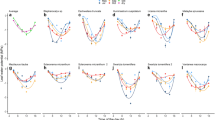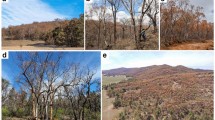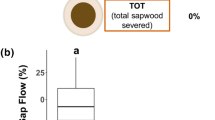Abstract
Understanding the pathways through which drought stress kills woody vegetation can improve projections of the impacts of climate change on ecosystems and carbon-cycle feedbacks. Continuous in situ measurements of whole trees during drought and as trees die hold promise to illuminate physiological pathways but are relatively rare. We monitored leaf characteristics, water use efficiency, water potentials, branch hydraulic conductivity, soil moisture, meteorological variables, and sap flux on mature healthy and sudden aspen decline-affected (SAD) trembling aspen (Populus tremuloides) ramets over two growing seasons, including a severe summer drought. We calculated daily estimates of whole-ramet hydraulic conductance and modeled whole-ramet assimilation. Healthy ramets experienced rapid declines of whole-ramet conductance during the severe drought, providing an analog for what likely occurred during the previous drought that induced SAD. Even in wetter periods, SAD-affected ramets exhibited fivefold lower whole-ramet hydraulic conductance and sevenfold lower assimilation than counterpart healthy ramets, mediated by changes in leaf area, water use efficiency, and embolism. Extant differences between healthy and SAD ramets reveal that ongoing multi-year forest die-off is primarily driven by loss of whole-ramet hydraulic capability, which in turn limits assimilation capacity. Branch-level measurements largely captured whole-plant hydraulic limitations during drought and mortality, but whole-plant measurements revealed a potential role of other losses in the hydraulic continuum. Our results highlight the importance of a whole-tree perspective in assessing physiological pathways to tree mortality and indicate that the effects of mortality on these forests’ assimilation and productivity are larger than expected based on canopy leaf area differences.







Similar content being viewed by others
References
Adams HD et al (2009) Temperature sensitivity of drought-induced tree mortality portends increased regional die-off under global-change-type drought. Proc Natl Acad Sci USA 106:7063–7066
Allen CD et al (2010) A global overview of drought and heat-induced tree mortality reveals emerging climate change risks for forests. For Ecol Manag 259:660–684. doi:10.1016/j.foreco.2009.09.001
Anderegg W (2012) Complex aspen forest carbon and root dynamics during drought. Clim Change 111:983–991
Anderegg WRL, Berry JA, Field CB (2012a) Linking definitions, mechanisms, and modeling of drought-induced tree death. Trends Plant Sci 17:693–700
Anderegg WRL, Berry JA, Smith DD, Sperry JS, Anderegg LDL, Field CB (2012b) The roles of hydraulic and carbon stress in a widespread climate-induced forest die-off. Proc Natl Acad Sci USA 109:233–237
Anderegg WRL, Kane JM, Anderegg LDL (2012c) Consequences of widespread tree mortality triggered by drought and temperature stress. Nat Clim. 3:30–36
Anderegg LDL, Anderegg WRL, Abatzoglou J, Hausladen AM, Berry JA (2013a) Drought characteristics’ role in widespread aspen forest mortality across Colorado, USA. Glob Change Biol 19:1526–1537. doi:10.1111/gcb.12146
Anderegg WRL, Plavcová L, Anderegg LDL, Hacke UG, Berry JA, Field CB (2013b) Drought’s legacy: multiyear hydraulic deterioration underlies widespread aspen forest die-off and portends increased future risk. Glob Change Biol 19:1188–1196
Barr AG et al (2007) Climatic controls on the carbon and water balances of a boreal aspen forest, 1994–2003. Glob Change Biol 13:561–576
Becker P, Tyree MT, Tsuda M (1999) Hydraulic conductances of angiosperms versus conifers: similar transport sufficiency at the whole-plant level. Tree Physiol 19:445–452
Bonan GB (2008) Forests and climate change: forcings, feedbacks, and the climate benefits of forests. Science 320:1444–1449. doi:10.1126/science.1155121
Bowling DR, Burns SP, Conway TJ, Monson RK, White JWC (2005) Extensive observations of CO2 carbon isotope content in and above a high-elevation subalpine forest. Glob Biogeochem. Cycles 19:GB3023. doi: 10.1029/2004GB002394
Brodribb TJ (2009) Xylem hydraulic physiology: the functional backbone of terrestrial plant productivity. Plant Sci 177:245–251. doi:10.1016/j.plantsci.2009.06.001
Brodribb TJ, Feild TS (2000) Stem hydraulic supply is linked to leaf photosynthetic capacity: evidence from New Caledonian and Tasmanian rainforests. Plant Cell Environ 23:1381–1388. doi:10.1046/j.1365-3040.2000.00647.x
Brugnoli E, Hubick KT, von Caemmerer S, Wong SC, Farquhar GD (1988) Correlation between the carbon isotope discrimination in leaf starch and sugars of C3 plants and the ratio of intercellular and atmospheric partial pressures of carbon dioxide. Plant Physiol 88:1418–1424. doi:10.1104/pp.88.4.1418
Choat B et al (2012) Global convergence in the vulnerability of forests to drought. Nature 491:752–755
Clearwater MJ, Meinzer FC, Andrade JL, Goldstein G, Holbrook NM (1999) Potential errors in measurement of nonuniform sap flow using heat dissipation probes. Tree Physiol 19:681–687. doi:10.1093/treephys/19.10.681
Easterling DR, Evans JL, Groisman PY, Karl TR, Kunkel KE, Ambenje P (2000) Observed variability and trends in extreme climate events: a brief review. Bull Am Meteorol Soc 81:417–425
Ewers BE, Oren R, Sperry JS (2000) Influence of nutrient versus water supply on hydraulic architecture and water balance in Pinus taeda. Plant Cell Environ 23:1055–1066
Ewers BE, Gower ST, Bond-Lamberty B, Wang CK (2005) Effects of stand age and tree species on canopy transpiration and average stomatal conductance of boreal forests. Plant Cell Environ 28:660–678. doi:10.1111/j.1365-3040.2005.01312.x
Farquhar G, O’Leary M, Berry J (1982) On the relationship between carbon isotope discrimination and the intercellular carbon dioxide concentration in leaves. Aust J Plant Physiol 9:121–137
Fisher R et al (2010) Assessing uncertainties in a second-generation dynamic vegetation model caused by ecological scale limitations. New Phytol 187:666–681
Frazer GW, Canham CD, Lertzman KP (1999) Gap Light Analyzer (GLA), Version 2.0: Imaging software to extract canopy structure and gap light transmission indices from true- colour fisheye photographs, users manual and program documentation. Simon Fraser University, Burnaby
Galiano L, Martínez-Vilalta J, Lloret F (2011) Carbon reserves and canopy defoliation determine the recovery of Scots pine 4 yr after a drought episode. New Phytol 190:750–759
Galvez DA, Landhäusser SM, Tyree MT (2011) Root carbon reserve dynamics in aspen seedlings: does simulated drought induce reserve limitation? Tree Physiol 31:250–257. doi:10.1093/treephys/tpr012
Granier A, Loustau D (1994) Measring and modeling the transpiration of a maritime pine canopu from sap-flow data. Agric For Meteorol 71:61–81
Hacke UG, Stiller V, Sperry JS, Pittermann J, McCulloh KA (2001) Cavitation fatigue. Embolism and refilling cycles can weaken the cavitation resistance of xylem. Plant Physiol 125:779–786
Hartmann H, Ziegler W, Trumbore S (2013) Lethal drought leads to reduction in nonstructural carbohydrates in Norway spruce tree roots but not in the canopy. Funct Ecol 27:413–427. doi:10.1111/1365-2435.12046
Hogg EH et al (1997) A comparison of sap flow and eddy fluxes of water vapor from a boreal deciduous forest. J Geophys Res Atmos 102:28929–28937
Hölttä T, Mencuccini M, Nikinmaa E (2009) Linking phloem function to structure: analysis with a coupled xylem–phloem transport model. J Theor Biol 259:325–337. doi:10.1016/j.jtbi.2009.03.039
Hu J, Moore DJP, Riveros-Iregui DA, Burns SP, Monson RK (2010) Modeling whole-tree carbon assimilation rate using observed transpiration rates and needle sugar carbon isotope ratios. New Phytol 185:1000–1015. doi:10.1111/j.1469-8137.2009.03154.x
Huang C-Y, Anderegg WRL (2012) Large drought-induced aboveground live biomass losses in southern Rocky Mountain aspen forests. Glob Change Biol 18:1016–1027
IPCC (2007) Contribution of Working Groups I, II and III to the Fourth Assessment Report of the Intergovernmental Panel on Climate Change. IPCC, Geneva
Kane J, Kolb T (2010) Importance of resin ducts in reducing ponderosa pine mortality from bark beetle attack. Oecologia 164:601–609. doi:10.1007/s00442-010-1683-4
Katul GG, Palmroth S, Oren RAM (2009) Leaf stomatal responses to vapour pressure deficit under current and CO2-enriched atmosphere explained by the economics of gas exchange. Plant Cell Environ 32:968–979
McDowell NG, Beerling DJ, Breshears DD, Fisher RA, Raffa KF, Stitt M (2011) The interdependence of mechanisms underlying climate-driven vegetation mortality. Trends Ecol Evol 26:523–532. doi:10.1016/j.tree.2011.06.003
Mencuccini M (2003) The ecological significance of long-distance water transport: short-term regulation, long-term acclimation and the hydraulic costs of stature across plant life forms. Plant Cell Environ 26:163–182. doi:10.1046/j.1365-3040.2003.00991.x
Michaelian M, Hogg EH, Hall RJ, Arsenault E (2011) Massive mortality of aspen following severe drought along the southern edge of the Canadian boreal forest. Glob Change Biol 17:2084–2094. doi:10.1111/j.1365-2486.2010.02357.x
Nikinmaa E et al (2013) Assimilate transport in phloem sets conditions for leaf gas exchange. Plant Cell Environ 36:655–669. doi:10.1111/pce.12004
Oishi AC, Oren R, Stoy PC (2008) Estimating components of forest evapotranspiration: a footprint approach for scaling sap flux measurements. Agric For Meteorol 148:1719–1732
Oren R et al (1999) Survey and synthesis of intra- and interspecific variation in stomatal sensitivity to vapour pressure deficit. Plant Cell Environ 22:1515–1526
Pan Y et al (2011) A large and persistent carbon sink in the world’s forests. Science 333:988–993. doi:10.1126/science.1201609
Peng C et al (2011) A drought-induced pervasive increase in tree mortality across Canada’s boreal forests. Nat Clim Change 1:467–471
Perala DA (1990) Populus tremuloides Michx. Quaking aspen. In: Burns RM, Honkala BH (eds). Silvics of North America, vol 2: Hardwoods. USDA Forest Service Agricultural Handbook 654. US Forest Service, Washington, DC, pp 555–569
Phillips OL et al (2010) Drought-mortality relationships for tropical forests. New Phytol 187:631–646. doi:10.1111/j.1469-8137.2010.03359.x
Plaut JA et al (2012) Hydraulic limits preceding mortality in a piñon–juniper woodland under experimental drought. Plant Cell Environ 35:1601–1617
Richter A et al (2009) Preparation of starch and soluble sugars of plant material for the analysis of carbon isotope composition: a comparison of methods. Rapid Commun Mass Spectrom 23:2476–2488. doi:10.1002/rcm.4088
Sala A, Woodruff DR, Meinzer FC (2012) Carbon dynamics in trees: feast or famine? Tree Physiol. doi: 10.1093/treephys/tpr143
Schneider CA, Rasband WS, Eliceiri KW (2012) NIH Image to ImageJ: 25 years of image analysis. Nat Meth 9:671–675
Seibt U, Rajabi A, Griffiths H, Berry JA (2008) Carbon isotopes and water use efficiency: sense and sensitivity. Oecologia (Berlin) 155:441–454. doi:10.1007/s00442-007-0932-7
Sperry JS (2011) Hydraulics of vascular water transport mechanical integration of plant cells and plants, vol 9. In: Wojtaszek P (ed) Signalling and communication in plants: mechanical integration of plant cells and plants. Springer, Heidelberg, pp 303–327
Sperry JS, Donnelly JR, Tyree MT (1988) A method for measuring hydraulic conductivity and embolism in xylem. Plant Cell Environ 11:35–40. doi:10.1111/j.1365-3040.1988.tb01774.x
Sperry JS, Adler FR, Campbell GS, Comstock JP (1998) Limitation of plant water use by rhizosphere and xylem conductance: results from a model. Plant Cell Environ 21:347–359. doi:10.1046/j.1365-3040.1998.00287.x
van Mantgem PJ et al (2009) Widespread increase of tree mortality rates in the western United States. Science 323:521–524. doi:10.1126/science.1165000
West AG, Hultine KR, Sperry JS, Bush SE, Ehleringer JR (2008) Transpiration and hydraulic strategies in a piñon-juniper woodland. Ecol Appl 18:911–927
Worrall JJ et al (2008) Rapid mortality of Populus tremuloides in southwestern Colorado, USA. For Ecol Manag 255:686–696. doi:10.1016/j.foreco.2007.09.071
Worrall JJ, Marchetti SB, Egeland L, Mask RA, Eager T, Howell B (2010) Effects and etiology of sudden aspen decline in southwestern Colorado, USA. For Ecol Manag 260:638–648. doi::10.1016/j.foreco.2010.05.020
Wullschleger SD, Meinzer FC, Vertessy RA (1998) A review of whole-plant water use studies in tree. Tree Physiol 18:499–512. doi:10.1093/treephys/18.8-9.499
Monteith JL, Unsworth M (1990) Principles of environmental physics. Butterworth-Heinemann, Woburn
Acknowledgments
We thank K. Pham, G. Griffin, M. Anderegg, E. Callaway, C. Kucharczyk, L. Giles and M. Dini for assistance in field and laboratory work, and an anonymous reviewer for helpful comments. Funding for study: NSF DDIG Program. W.R.L.A. was supported in part by an award from the Department of Energy (DOE) Office of Science Graduate Fellowship Program (DOE SCGF) and a NOAA Climate and Global Change Postdoctoral Fellowship.
Author information
Authors and Affiliations
Corresponding author
Additional information
Communicated by Ram Oren.
Electronic supplementary material
Below is the link to the electronic supplementary material.
Rights and permissions
About this article
Cite this article
Anderegg, W.R.L., Anderegg, L.D.L., Berry, J.A. et al. Loss of whole-tree hydraulic conductance during severe drought and multi-year forest die-off. Oecologia 175, 11–23 (2014). https://doi.org/10.1007/s00442-013-2875-5
Received:
Accepted:
Published:
Issue Date:
DOI: https://doi.org/10.1007/s00442-013-2875-5




